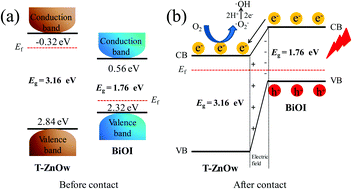Facile preparation of BiOI/T-ZnOw p–n heterojunction photocatalysts with enhanced removal efficiency for rhodamine B and oxytetracycline†
Abstract
The construction of p–n heterojunctions instead of p-type or n-type semiconductors can improve the separation efficiency of photoinduced electrons and holes. In this work, BiOI/tetrapod-like ZnO whisker (T-ZnOw) p–n heterojunction photocatalysts with different Bi/Zn molar ratios were prepared by the in situ precipitation of BiOI on a T-ZnOw substrate. The BiOI/T-ZnOw photocatalysts efficiently degraded rhodamine B (RhB) and oxytetracycline (OTC) under visible light irradiation. The photocatalyst with a Bi/Zn molar ratio of 1 : 10 (BZ-10) exhibited the highest photocatalytic activity, with 97.1% and 88.0% removal of RhB and OTC, respectively. After degradation cycling experiments, the OTC removal efficiency was still 80.7%. The photocatalytic activity of the BZ-10 composite was improved compared to those of pure T-ZnOw and BiOI. This was attributed to the large specific surface area and the efficient separation of charge carriers caused by the formation of p–n heterojunctions between BiOI and T-ZnOw. The photodegradation mechanism was put forward based on radical trapping experiments and electron spin resonance (ESR) results. The synthesized BiOI/T-ZnOw heterojunction composite could be a promising photocatalyst in environmental photocatalysis.



 Please wait while we load your content...
Please wait while we load your content...